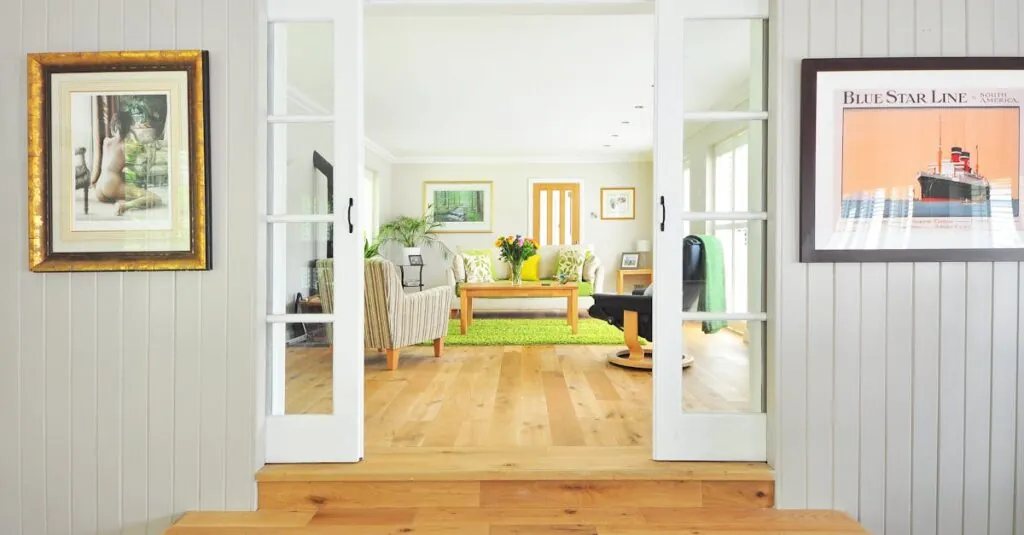In a world overflowing with stuff, the modern minimalist living room stands as a serene oasis. Imagine stepping into a space where less truly means more—more tranquility, more style, and definitely more room for activities that don’t involve tripping over a pile of throw pillows.
Embracing minimalism doesn’t just declutter your space; it declutters your mind too. With clean lines and a neutral palette, these living rooms invite peace and creativity. Whether you’re a busy professional or a homebody who loves to binge-watch the latest series, a minimalist approach can transform your living area into a chic sanctuary. Get ready to discover ideas that’ll make you want to toss out that old recliner and embrace a sleek, modern vibe. Your future self will thank you (and so will your guests, who won’t have to navigate through a maze of knick-knacks).
Table of Contents
ToggleUnderstanding Modern Minimalist Design
Modern minimalist design emphasizes simplicity and functionality. This approach creates an environment that fosters tranquility and balance.
Key Principles of Minimalism
First, minimalism focuses on clean lines and uncluttered spaces. Neutral colors dominate, providing a calm backdrop for intentional decoration. Next, furniture and decor are chosen for their purpose, eliminating excess. Every piece serves a function and enhances the overall aesthetic. Moreover, negative space plays a key role. It creates room for the eye to rest and emphasizes essential elements in a living area.
Importance of Functionality
Functionality remains a core tenet of modern minimalist design. Spaces must serve their intended purposes efficiently. When selecting furniture, consider multipurpose items that maximize utility. Examples include a coffee table that doubles as storage or a sofa bed for guests. Prioritizing comfortable seating and practical layouts enhances daily living. Efficient arrangements allow for fluid movement and promote a welcoming atmosphere in the living room.
Color Palette for Modern Minimalist Living Rooms
Color choices play a vital role in modern minimalist living rooms. The right palette enhances simplicity and fosters tranquility.
Neutral Colors
Neutral colors form the foundation of modern minimalist design. Shades like white, beige, gray, and soft taupe serve as the backdrop, providing versatility. Light colors contribute to an airy, spacious feel, while darker neutrals can add warmth and depth. Selecting these tones simplifies decoration and encourages a cohesive look. Soft textures and finishes further enhance the appeal, making the space inviting yet uncluttered. For instance, a white sofa paired with gray pillows creates a serene atmosphere that complements minimalist principles.
Accent Colors
Using accent colors introduces distinct personality while maintaining a minimalist aesthetic. Bold choices like navy blue, forest green, or terracotta offer striking contrast without overwhelming the room. Integrating these hues in smaller decor items, like cushions, throws, or artwork, allows for flexibility and easy updates. Accent colors draw attention to key features without disrupting the overall calmness. A single vibrant piece, such as a bright artwork, can emphasize functionality and charm while supporting the minimalist approach. Prioritizing subtlety in accents strengthens the balance essential to modern minimalist living rooms.
Furniture Selection for Minimalist Spaces
Furniture selection plays a crucial role in achieving a modern minimalist living room. Prioritizing functionality and simplicity ensures a harmonious atmosphere where every piece contributes to the overall aesthetic.
Choosing the Right Sofa
Selecting the right sofa establishes the foundation of minimalist living rooms. Look for clean lines and a low-profile design that complements the space. Neutral colors like gray, beige, or white provide versatility and blend seamlessly with other elements. Opting for a loveseat or sectional can maximize seating without overwhelming the room. Sofas with removable covers offer practicality and ease of maintenance, while avoiding excessive ornamentation keeps the focus on the room’s peaceful ambiance.
Multipurpose Furniture Options
Multipurpose furniture enhances functionality within minimalist spaces. Consider items that serve dual roles, such as a coffee table with storage or an ottoman that doubles as seating. Use a shelving unit that acts as both a display area and room divider to create distinct zones in an open floor plan. Foldable furniture, like wall-mounted desks or drop-leaf tables, allows for adaptability in smaller areas. Prioritizing these versatile pieces maintains a clean and uncluttered look while providing essential utility.
Decor and Accessories
Minimalist living rooms thrive on thoughtful decor and accessories that enhance simplicity. Each chosen piece should contribute to the overall ambiance without cluttering the space.
Art and Wall Decor
Art plays a crucial role in establishing character within minimalist living rooms. Select large-scale pieces that serve as focal points, providing visual interest without overwhelming the space. Opt for abstract prints in neutral palettes or monochromatic photography to maintain the serene atmosphere. Wall shelves can showcase carefully curated objects, adding dimension while remaining functional. Incorporating mirrors also amplifies natural light, enhancing the sense of openness. Limit the number of items displayed to prevent distraction and ensure a cohesive look throughout the room.
Textiles and Soft Furnishings
Textiles add warmth and comfort to minimalist living rooms while adhering to simplicity. Choose throw pillows and blankets in soft textures, neutral colors, or subtle patterns for a chic touch. Area rugs should provide comfort underfoot while defining spaces, preferably with a low pile and simple design. Window treatments require attention as well; lightweight fabrics like sheer linen enhance light flow and maintain an airy feel. Each textile element must complement the minimalist ethos, contributing to a calm and inviting environment. Prioritize quality over quantity to ensure each piece enriches the living space meaningfully.
Lighting in a Minimalist Living Room
Effective lighting can elevate a minimalist living room’s ambiance. Combining natural and artificial light creates an inviting atmosphere that maximizes space.
Natural Light Utilization
Natural light plays a critical role in minimalist design. Large windows let daylight flood the room, amplifying the feeling of openness. Positioning mirrors across from windows reflects light, which brightens the space. Utilizing sheer curtains allows light to filter in while maintaining privacy. Skylights also provide additional sunlight, enriching the overall feel of the room.
Selecting Light Fixtures
Selecting the right light fixtures enhances a minimalist living room’s aesthetic. Pendant lights with clean lines serve as functional art pieces, drawing attention without overwhelming the space. Floor lamps can provide added illumination while maintaining a sleek profile. When choosing table lamps, opt for designs that prioritize simplicity and elegance. In addition, adjustable lighting allows for versatility, adapting to different moods and activities in the living room.
Common Mistakes to Avoid
Modern minimalist living rooms can easily misstep into overdecorated spaces or detach from personal expression. Recognizing these common pitfalls helps maintain the intended aesthetic and emotional connection.
Overdecorating the Space
Maximizing every corner with decor detracts from minimalist principles. Too many decorative items can create visual chaos rather than tranquility. Opt for fewer, statement pieces that serve a clear function or meaning. Choose large-scale art or a single striking vase to draw the eye, ensuring these selections harmonize with the overall design. Simplifying choices not only maintains clean lines but also enhances the calming atmosphere that minimalism promotes. Aim for balance, letting key elements breathe within the space instead of competing for attention.
Ignoring Personal Touches
Minimalism thrives on intentionality, yet a common error involves neglecting personal expression. Leaving out meaningful decor or family photos creates a sterile environment. Integrating a few well-chosen, cherished items adds warmth and personality to the room’s design. Select unique artwork or treasured mementos that reflect individual style while complementing the minimalist ethos. Personal touches should enhance the space without overwhelming it. Aim for a curated feel, combining essential minimalist elements with personal significance to foster a comfortable, inviting atmosphere.
Embracing modern minimalist living room ideas can truly transform a space into a serene retreat. By focusing on simplicity and functionality, individuals can create an environment that not only looks stylish but also promotes mental clarity. Thoughtful furniture selection and intentional decor choices ensure that every element serves a purpose while maintaining an airy feel.
Incorporating neutral color palettes and soft textures enhances the inviting nature of the room. With the right lighting and a few statement pieces, a minimalist living room can reflect personal style without overwhelming the senses. As they embark on this journey toward minimalism, individuals will discover that less truly can be more, leading to a more peaceful and enjoyable living experience.









